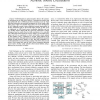Free Online Productivity Tools
i2Speak
i2Symbol
i2OCR
iTex2Img
iWeb2Print
iWeb2Shot
i2Type
iPdf2Split
iPdf2Merge
i2Bopomofo
i2Arabic
i2Style
i2Image
i2PDF
iLatex2Rtf
Sci2ools
92
Voted
IPSN
2007
Springer
2007
Springer
An empirical study of collaborative acoustic source localization
— Field biologists use animal sounds to discover the presence of individuals and to study their behavior. Collecting bio-acoustic data has traditionally been a difficult and time-consuming process in which individual researchers use portable microphones to record sounds while taking notes of their own detailed observations. The recent development of new deployable acoustic sensor platforms presents opportunities to develop automated tools for bio-acoustic field research. In this work, we implement an AML-based source localization algorithm, and use it to localize marmot alarm-calls. We assess the performance of these techniques based on results from two field experiments: (1) a controlled test of direction-of-arrival (DOA) accuracy using a pre-recorded source signal, and (2) an experiment to detect and localize actual animals in their habitat, with a comparison to ground truth gathered from human observations. Although small arrays yield ambiguities from spatial aliasing of high f...
Related Content
| Added | 08 Jun 2010 |
| Updated | 08 Jun 2010 |
| Type | Conference |
| Year | 2007 |
| Where | IPSN |
| Authors | Andreas M. Ali, Kung Yao, Travis C. Collier, Charles E. Taylor, Daniel T. Blumstein, Lewis Girod |
Comments (0)

